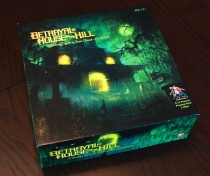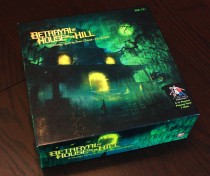Daily Archives: September 30, 2014

Ernest Adams workshop: Call of Beauty
Two weeks earlier (whoo, how time flies!) we had the Ernest Adams “Fundamental Principles of Game Design”-workshop, which served as an interesting first “proper”, structured group-project in the course. This post is a combined re-telling of events and reflections on the project, snuggled up in a heap of TEXT and BULLET LISTS. Enjoy!
The workshop began with a presentation about (amongst other things):
What is a game?
Types of fun in video games.
The components of gameplay.
Types of challenges.
Interweaving narrative and gameplay.
The most important take-aways from […]

Ernest Adams workshop: Call of Beauty
Two weeks earlier (whoo, how time flies!) we had the Ernest Adams “Fundamental Principles of Game Design”-workshop, which served as an interesting first “proper”, structured group-project in the course. This post is a combined re-telling of events and reflections on the project, snuggled up in a heap of TEXT and BULLET LISTS. Enjoy!
The workshop began with a presentation about (amongst other things):
What is a game?
Types of fun in video games.
The components of gameplay.
Types of challenges.
Interweaving narrative and gameplay.
The most important take-aways from […]
Week 4.
This week we were given the assignment to create a playable paperback game in 24 hours.
We were told to choose an already existing game and duplicate the player experience from that game. To do this we had to analyze what we liked about it, what was the games essence, and cut it out of the game and turn it applicable in a paperback prototype of that game. For example: one team chose tetris, which to them was a timed challenge […]
Week 4.
This week we were given the assignment to create a playable paperback game in 24 hours.
We were told to choose an already existing game and duplicate the player experience from that game. To do this we had to analyze what we liked about it, what was the games essence, and cut it out of the game and turn it applicable in a paperback prototype of that game. For example: one team chose tetris, which to them was a timed challenge […]
Week 4.
This week we were given the assignment to create a playable paperback game in 24 hours.
We were told to choose an already existing game and duplicate the player experience from that game. To do this we had to analyze what we liked about it, what was the games essence, and cut it out of the game and turn it applicable in a paperback prototype of that game. For example: one team chose tetris, which to them was a timed challenge […]
Week 4.
This week we were given the assignment to create a playable paperback game in 24 hours.
We were told to choose an already existing game and duplicate the player experience from that game. To do this we had to analyze what we liked about it, what was the games essence, and cut it out of the game and turn it applicable in a paperback prototype of that game. For example: one team chose tetris, which to them was a timed challenge […]
An Introduction to Introductory Programming with Java
I’m currently studying a course called Introductory Programming with Java (Swe: Inlednande Programming med Java) at Campus Gotland.
In the course, we work with an Interactive Development Environment called Greenfoot. The environment comes with functionality that can be used to develop simple top-down games like 2D-shooters or simple puzzle games.
So far this course has been going pretty smoothly for me, as the course is meant for people who are completely new to programming. And compared to what I’ve been thought […]
An Introduction to Introductory Programming with Java
I’m currently studying a course called Introductory Programming with Java (Swe: Inlednande Programming med Java) at Campus Gotland.
In the course, we work with an Interactive Development Environment called Greenfoot. The environment comes with functionality that can be used to develop simple top-down games like 2D-shooters or simple puzzle games.
So far this course has been going pretty smoothly for me, as the course is meant for people who are completely new to programming. And compared to what I’ve been thought […]
Wall sliding!
Today I was busy doing other stuff and therefore I did not have much time to program. But I managed to squeeze in some time and finish the last variable for the players basic movement, wall sliding. The player now slides down slower if he is touching a wall, in comparison to just falling faster with gravity. The sliding works by applying an small upwards force when the player is touching a wall and has a negative velocity value on Y-axis.
I […]
Wall sliding!
Today I was busy doing other stuff and therefore I did not have much time to program. But I managed to squeeze in some time and finish the last variable for the players basic movement, wall sliding. The player now slides down slower if he is touching a wall, in comparison to just falling faster with gravity. The sliding works by applying an small upwards force when the player is touching a wall and has a negative velocity value on Y-axis.
I […]

Board Game Analysis: Betrayal at House on the Hill
Betrayal at House on the Hill is a very narrative-based board game for 3-6 players of ages 12 and older. The scenario is that the players are a group of explorers, exploring an old haunted house. Whilst exploring the house one player suddenly turns into a traitor, sometimes gaining control of monsters, and the game turns from exploring to a fight for survival between the traitor and the rest of the players. The fight between the players can however […]

Board Game Analysis: Betrayal at House on the Hill
Betrayal at House on the Hill is a very narrative-based board game for 3-6 players of ages 12 and older. The scenario is that the players are a group of explorers, exploring an old haunted house. Whilst exploring the house one player suddenly turns into a traitor, sometimes gaining control of monsters, and the game turns from exploring to a fight for survival between the traitor and the rest of the players. The fight between the players can however […]

Board Game Analysis: Betrayal at House on the Hill
Betrayal at House on the Hill is a very narrative-based board game for 3-6 players of ages 12 and older. The scenario is that the players are a group of explorers, exploring an old haunted house. Whilst exploring the house one player suddenly turns into a traitor, sometimes gaining control of monsters, and the game turns from exploring to a fight for survival between the traitor and the rest of the players. The fight between the players can however […]

Board Game Analysis: Betrayal at House on the Hill
Betrayal at House on the Hill is a very narrative-based board game for 3-6 players of ages 12 and older. The scenario is that the players are a group of explorers, exploring an old haunted house. Whilst exploring the house one player suddenly turns into a traitor, sometimes gaining control of monsters, and the game turns from exploring to a fight for survival between the traitor and the rest of the players. The fight between the players can however […]